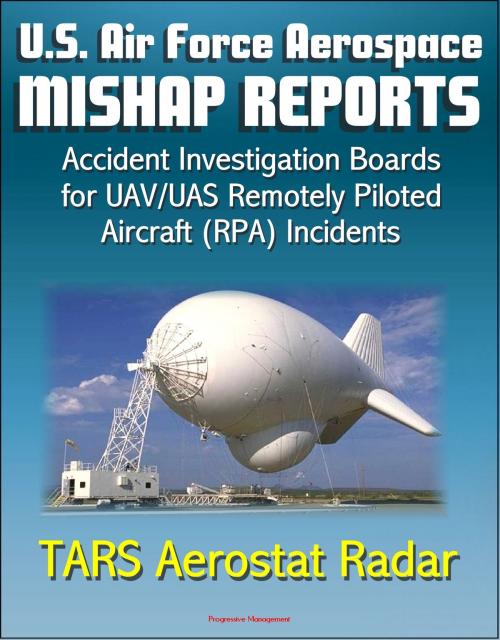U.S. Air Force Aerospace Mishap Reports: Accident Investigation Boards for Incidents Involving the TARS Tethered Aerostat Radar System in 2011 and 2012
Nonfiction, Science & Nature, Technology, Aeronautics & Astronautics, History, Military, Aviation| Author: | Progressive Management | ISBN: | 9781476215143 |
| Publisher: | Progressive Management | Publication: | August 11, 2012 |
| Imprint: | Smashwords Edition | Language: | English |
| Author: | Progressive Management |
| ISBN: | 9781476215143 |
| Publisher: | Progressive Management |
| Publication: | August 11, 2012 |
| Imprint: | Smashwords Edition |
| Language: | English |
Three USAF accident investigation board reports, converted for accurate flowing-text ebook format reproduction, present findings into Class A aerospace mishaps involving the TARS Tethered Aerostat Radar System. The Tethered Aerostat Radar System (TARS) is a program managed by Air Combat Command's Acquisition Management and Integration Center. ITT Exelis is the contractor responsible for operating and maintaining the Marfa TARS, which is manned solely by ITT personnel.
Report One: The mishap aerostat (MA) was launched on 6 May 2011 from Fort Huachuca, Arizona and was on station at 2256 ZULU (Z) (1556 local time) until the mishap. At approximately 2013Z on 9 May 2011, the MA's tether broke, causing the aerostat to breakaway. Shortly after the tether broke, the MA, tore apart in-flight causing the associated equipment to impact the ground and be destroyed with the loss valued at approximately $8,819,487.86. There were no injuries and the accident caused minor damage to private property.
Report Two: The mishap aerostat (MA) was launched on 15 August 2011 from the Lajas Tethered Aerostat Radar System (TARS) Site, Puerto Rico at 1241 ZULU (Z) (0841 local time) and remained aloft until the mishap. At approximately 1637Z on 16 August 2011, a line of thunderstorms hit the site from the SE. Heavy winds blew the MA abruptly to the NW of the site, pulling the mishap winch truck (MWT) off of the pad and into an embankment at the site perimeter. The MA tether was pulled along a steel anti-fouling cable and snapped. The MA broke away, climbed to 7,000 feet and ruptured, causing the associated equipment to impact the ground and be destroyed with total loss and damage estimated at $8,159,917.86. There were no injuries and no significant damage to private property.
Report Three: The mishap aerostat (MA) was launched on 14 Feb 12 from the Marfa TARS Site, Texas at 0421 Zulu (Z) (2321 local time), Flight #535, and remained aloft until recovery operations that culminated in the mishap. At 2115Z the Mishap Flight Director 1 (MFD 1) received an erroneous surface wind warning cancellation from the Mishap Telemetry and Control 1 (MT&C 1). This was not a cancellation, but an upgrade from a watch to a warning. The MFD 1 had knowledge of, and was briefed, on the upper level turbulence and pending high surface level winds from an electronic briefing received at 2300Z. At 2344Z, upper level winds and turbulence caused the MFD 1 to begin an adjustment. At 2350Z this adjustment became a recovery.
Three USAF accident investigation board reports, converted for accurate flowing-text ebook format reproduction, present findings into Class A aerospace mishaps involving the TARS Tethered Aerostat Radar System. The Tethered Aerostat Radar System (TARS) is a program managed by Air Combat Command's Acquisition Management and Integration Center. ITT Exelis is the contractor responsible for operating and maintaining the Marfa TARS, which is manned solely by ITT personnel.
Report One: The mishap aerostat (MA) was launched on 6 May 2011 from Fort Huachuca, Arizona and was on station at 2256 ZULU (Z) (1556 local time) until the mishap. At approximately 2013Z on 9 May 2011, the MA's tether broke, causing the aerostat to breakaway. Shortly after the tether broke, the MA, tore apart in-flight causing the associated equipment to impact the ground and be destroyed with the loss valued at approximately $8,819,487.86. There were no injuries and the accident caused minor damage to private property.
Report Two: The mishap aerostat (MA) was launched on 15 August 2011 from the Lajas Tethered Aerostat Radar System (TARS) Site, Puerto Rico at 1241 ZULU (Z) (0841 local time) and remained aloft until the mishap. At approximately 1637Z on 16 August 2011, a line of thunderstorms hit the site from the SE. Heavy winds blew the MA abruptly to the NW of the site, pulling the mishap winch truck (MWT) off of the pad and into an embankment at the site perimeter. The MA tether was pulled along a steel anti-fouling cable and snapped. The MA broke away, climbed to 7,000 feet and ruptured, causing the associated equipment to impact the ground and be destroyed with total loss and damage estimated at $8,159,917.86. There were no injuries and no significant damage to private property.
Report Three: The mishap aerostat (MA) was launched on 14 Feb 12 from the Marfa TARS Site, Texas at 0421 Zulu (Z) (2321 local time), Flight #535, and remained aloft until recovery operations that culminated in the mishap. At 2115Z the Mishap Flight Director 1 (MFD 1) received an erroneous surface wind warning cancellation from the Mishap Telemetry and Control 1 (MT&C 1). This was not a cancellation, but an upgrade from a watch to a warning. The MFD 1 had knowledge of, and was briefed, on the upper level turbulence and pending high surface level winds from an electronic briefing received at 2300Z. At 2344Z, upper level winds and turbulence caused the MFD 1 to begin an adjustment. At 2350Z this adjustment became a recovery.















